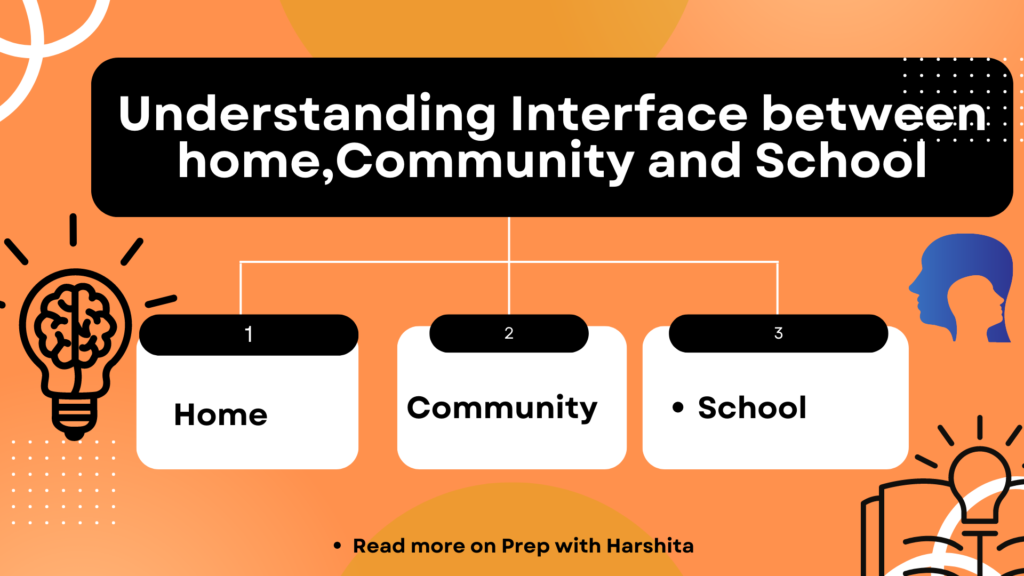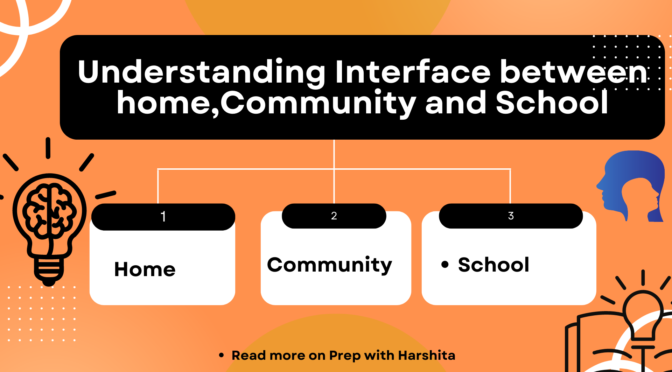The interface between home, community, and school is a critical aspect of a child’s development and education. These three spheres of influence play distinct yet interconnected roles in shaping a child’s learning, socialization, and overall well-being.
Here’s a breakdown of the interface between home, community, and school:
- Home and School Interface: The home-school interface refers to the collaboration and interaction between families and educational institutions. It is crucial for fostering effective communication, shared goals, and mutual support to enhance a child’s educational experience. Key aspects of the home-school interface include:
- Parental Involvement: Parents and guardians play a vital role in supporting their child’s education. This involvement can include assisting with homework, attending parent-teacher meetings, participating in school events, and engaging in open and regular communication with teachers.
- Shared Expectations: The home-school interface requires establishing shared expectations and goals between families and schools. This includes aligning academic expectations, behavior management approaches, and promoting a positive learning environment both at home and in school.
- Supportive Learning Environment: Collaboration between home and school can help create a supportive learning environment. Schools can share resources, strategies, and information with families to reinforce learning at home. Similarly, families can provide insights and support to educators to better understand their child’s needs and strengths.
- Parent-Teacher Communication: Effective communication channels between parents and teachers are crucial for sharing information, addressing concerns, and promoting a cohesive educational experience. Regular updates on a child’s progress, academic challenges, and social-emotional development help ensure a holistic understanding of the child’s needs.
- Community and School Interface: The community-school interface refers to the connection between educational institutions and the broader community in which they are situated. This interface recognizes the impact of community resources, partnerships, and involvement in enhancing educational opportunities. Key aspects of the community-school interface include:
- Community Partnerships: Collaborating with community organizations, businesses, and institutions enriches the educational experience. Partnerships can provide access to resources, mentorship programs, internships, and extracurricular activities that complement classroom learning.
- Service-Learning and Civic Engagement: Engaging students in service-learning projects and civic activities connects classroom learning to real-world experiences. Community involvement fosters a sense of civic responsibility, empathy, and active citizenship among students.
- Cultural Diversity and Inclusion: Schools should recognize and celebrate the diversity of their local community. Embracing cultural diversity through inclusive curricula, multicultural events, and community celebrations promotes understanding, respect, and inclusion among students.
- Resource Sharing: Community resources such as libraries, museums, sports facilities, and community centers can enhance educational opportunities. Schools can leverage these resources for field trips, guest speakers, workshops, and other learning experiences beyond the classroom.
- Home and Community Interface: The home-community interface recognizes the reciprocal relationship between families and the broader community in which they reside. This interface supports a child’s holistic development and well-being. Key aspects of the home-community interface include:
- Family Engagement in Community Activities: Families engaging in community activities, such as volunteering, attending local events, and participating in neighborhood associations, contribute to a sense of belonging and social connectedness.
- Utilizing Community Resources: Families can access community resources such as libraries, recreational facilities, and community centers to support their child’s learning, hobbies, and interests. These resources provide additional learning opportunities and social engagement.
- Networking and Social Support: The community provides opportunities for families to connect with other parents, caregivers, and families. Building social networks and support systems within the community can provide emotional support, information sharing, and opportunities for collaboration.
- Cultural and Social Experiences: The community offers diverse cultural and social experiences that complement and expand a child’s learning. Families can expose their children to local traditions, events, festivals, and community celebrations, fostering an appreciation for cultural diversity.
Understanding and fostering a strong interface between home, community, and school is essential for promoting a child’s holistic development, academic success, and overall well-being. Effective collaboration, communication, and shared goals among these three spheres of influence create a supportive and enriching environment for children to thrive.
Also Read : Difference between Primary and Secondary Socialization

Also Visit : Prep with Harshita

